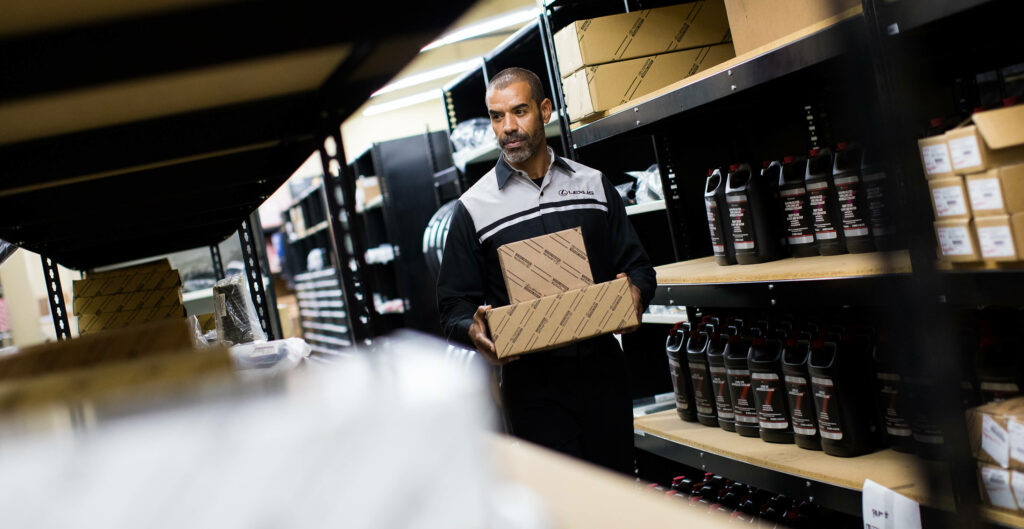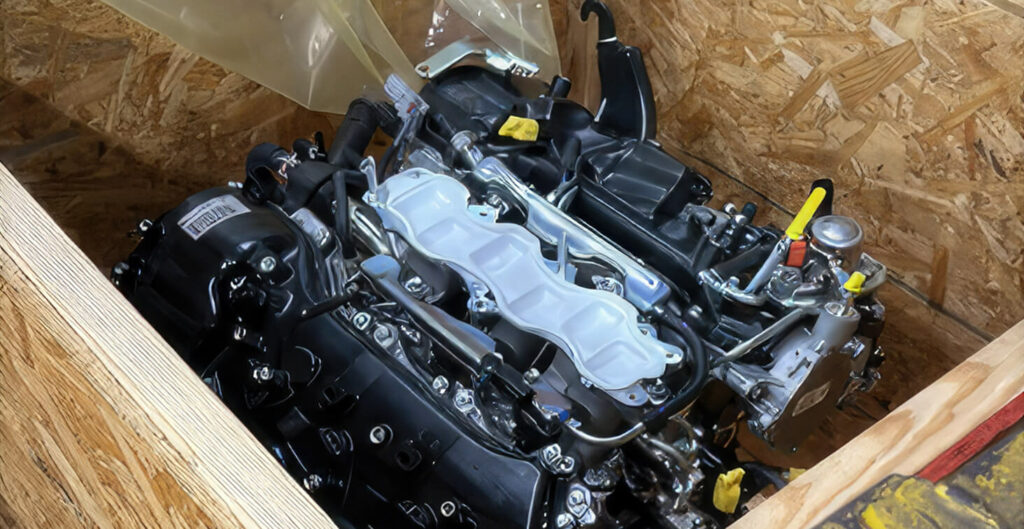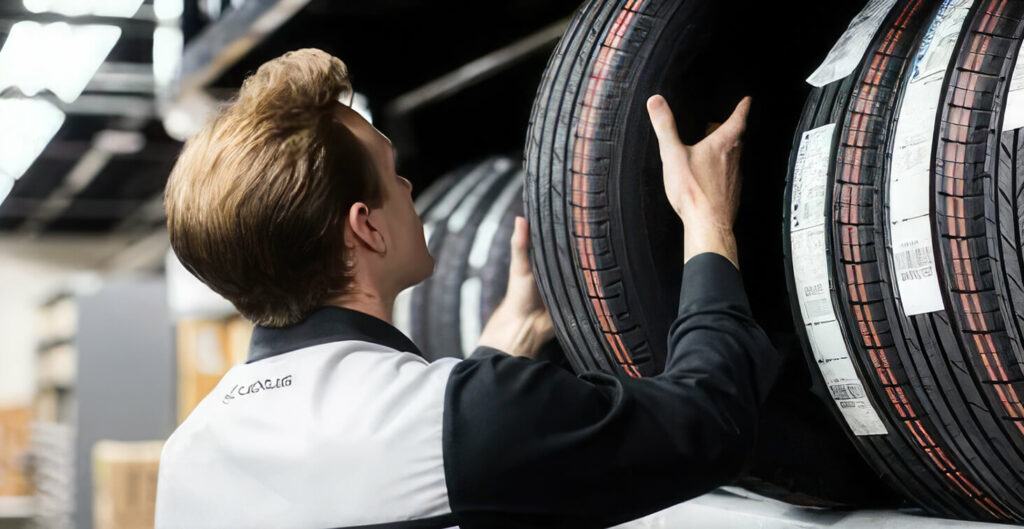
CUT THE CLUTTER
7 STORAGE TECHNIQUES—CUBIC EFFICIENCY = FISCAL PROFICIENCY
Why should you consider organizing your parts department? Because it allows your technicians to easily access the necessary parts while they work on specific equipment. By creating more space for your technicians to move around, you’ll enhance their efficiency. A little investment in organization upfront can result in substantial long-term savings. To achieve this, let’s explore Toyota’s 7 storage techniques, rooted in the Toyota lean philosophy designed for warehouses. This approach prioritizes safety, quality, and productivity. Given the growing array of Lexus models, computerized inventory systems, and advanced safety features, Lexus dealers must optimize both space and time in order to boost the overall efficiency and profitability of their Parts Department.
An illustrative example of change is how certain parts departments still arrange items by their part number sequence, while others adopt an approach similar to a grocery store, grouping all air filters together and all spark plugs together. While this might appear logical, in practical terms, such organization can lead to time and space wastage.
“A grocery store purposely stocks things together to make it convenient for the customer, but that doesn’t work for someone who has to pull the parts. Now that we have quick access to data, we can stock the fastest-selling parts so they’re easy to pick, and the slowest-selling parts are the farthest away. The goal is to reduce time and steps.”
Jay Graham
Director Business Development & Dealer Managed Solutions
ADM

Unlock Your Space: Discover the Power of the 7 Storage Techniques
- Lexus dealers who have implemented this program report that 40% less space is typically required for parts storage.
- After implementing the 7 Storage Techniques, on average, a person takes 40% fewer steps to pick parts vs. a pre-7 Storage Parts Department.
- Shortening the time to stock, pick, and deliver parts, Parts Department personnel have more time to work on increasing wholesale and IRF business.

7 STORAGE TECHNIQUES – THE BASICS
- Store by Product
- Store by Movement Rate
- Store Long & Thin Parts Vertically
- Store Within Easy Reach
- Store Heavy, Awkward Parts Down Low
- Store in Separate Locations
- Control Irregularities
Step 1. Store by Product
- Fast-moving parts—air filters, cabin air filters, and engine oil filters – can be stored together to create less waste, create more efficient storage, and improve the picking process for parts professionals.
- Most efficient use of shelving space.

Step 2. Store by Movement Rate
- Reduces walking distances for parts picking.
- Use Inventory, part attribute, and sales data to optimize storage.
- Evaluate opportunities to move slow-moving parts.
Step 3. Store Long and Thin Parts Vertically
- Keeps similar parts together, which helps prevent damage.
- Reduces storage space.
- Keep faster moving parts lower to the ground to reduce the need to use a ladder and the risk of damage from dropping parts.
“We’ve seen a big shift. Nobody used to want to stock body parts. Now, they’re stocking fenders, hoods, bumper covers, and more – and 7 Storage Techniques helps them know their inventory and respond quicker to Independent Repair Facilities, so they can capture more of this business.”
Jay Graham
Director, Business Development & Dealer Managed Solutions
ADMI
Step 4. Store within Easy Reach
- Improves picking of parts for better productivity and accuracy.
- Use inventory and sales data to optimize storage – i.e., fast-moving parts are typically packaged in smaller cartons, weigh less, and are easier to manage.
- Keeping parts in the “Golden Zone” reduces the excessive movement for picking parts (the “Golden Zone” is the area nearest to the core of your body between your shoulders and knees).

Step 5. Store Larger Heavy Parts Down Low
- Storing heavier parts in ergonomically safe zones helps prevent personal back injuries.
- Heavier parts can be accessed with hand trucks, pallet jacks or sometimes a forklift.

Step 6. Store in Separate Locations
- Improves accuracy and minimizes damage by preventing dissimilar parts from being mixed.
- Utilize bin size and location to optimize parts similarity:
- Smaller parts can be stored horizontally in a smaller space based on movement/sales.
- Larger parts, like tires, require a larger space that can go vertically and can be pulled with ease.
Step 7. Control Irregularities
- Keeping the floors clean of obstructions keeps the department neat and organized to enhance the picking process.
- Can boost moral as it is easier to pick parts in an organized space.
WHERE TO BEGIN
Before a Lexus Parts Department embarks on the journey of implementing the 7 Storage Techniques, the initial step is to identify your primary area of activity. For instance, if your operation primarily serves wholesale customers, the focus should be on optimizing the staging area to expedite order processing and dispatch. Conversely, if your dealership places a greater emphasis on internal service, the organization should revolve around the back counter.
Lexus has partnered with ADMI to provide personalized support to dealers. This involves conducting a thorough site analysis and crafting a tailor-made action plan. Following the plan’s implementation, ADMI collaborates with your Parts Department to devise the perfect solution.
Boost Your Store’s Success
“Our goal is to help dealers make the most of their cubic space. There are so many SKUs, and the count keeps increasing, so inventory and storage are vital to success. Dealers must stock the right parts at the right inventory level and then store them for efficient picking. And together, that boosts operational efficiency and profitability,” concludes Jay Graham
Request Your Complimentary Sales Analysis Today!
CONTACTS:
Jay Graham at: jgraham@admiglobal.com
Helmut Nittmann at: hnittmann@admiglobal.com



